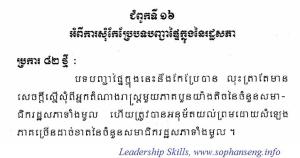Preamble:
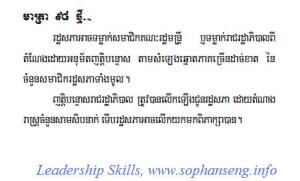 There are continual blame-games on Sam Rainsy who proposed CPP to amend the Constitution from Two Third Majority to Half plus One Majority, or Absolute Majority vote in the Assembly to create a new government. In 2006, the Cambodia Daily described in details this new approach that was in tense and government sent armed-security to safeguard Sam Rainsy by the proposal of opposition party members. From different perspectives, the move is a good choice to create a “Two Parties State” of Cambodia for a long run future. It has also encouraged the winning party to executing their executive members into more Responsible, Accountable, and Removable. Click on this link for numeral systems concerning Cambodia’s Political System of Assembly.
There are continual blame-games on Sam Rainsy who proposed CPP to amend the Constitution from Two Third Majority to Half plus One Majority, or Absolute Majority vote in the Assembly to create a new government. In 2006, the Cambodia Daily described in details this new approach that was in tense and government sent armed-security to safeguard Sam Rainsy by the proposal of opposition party members. From different perspectives, the move is a good choice to create a “Two Parties State” of Cambodia for a long run future. It has also encouraged the winning party to executing their executive members into more Responsible, Accountable, and Removable. Click on this link for numeral systems concerning Cambodia’s Political System of Assembly.
Absolute Majority within the National Constitution and Internal Regulation of the Assembly is Blurry:
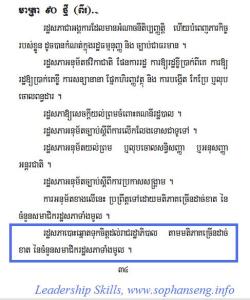 Last time I wrote “the people must hold government accountable and responsible, in which the government cabinet is answerable to, and removable by, the majority of parliamentarian” in which Majority here is very interesting.
Last time I wrote “the people must hold government accountable and responsible, in which the government cabinet is answerable to, and removable by, the majority of parliamentarian” in which Majority here is very interesting.
Majority could include “Simple Majority”, or “Absolute Majority”, or “Super Majority”. Here, I am going to articulate more on Cambodia’s adopted Majority or “half plus one” or “50% + 1” in which it is fallen into “Absolute Majority”. Majority itself could be mandated through all 120 Cambodian law-makers, or just those who are presenting during the vote. The internal rules of Cambodian assembly dictates that it must represent the whole 120 of parliamentarian in according to Article 41 (new) but it is already inscribed in the Constitution (pic attached). When I looked at Constitution in Article 90, it has still used unclear term “Absolute Majority”, or this version is too old (has not yet included the new amendment yet) (pic attached).
The National Assembly can dismiss any minister or the Royal Government from office by adopting “Blaming Notification” based on the absolute majority of the whole parliament members.
The Blaming Notification on the Royal Government must be raised to the National Assembly by at least 30 MPs so that the National Assembly can discuss it.
Institution Building through this Absolute Majority or Half + 1:
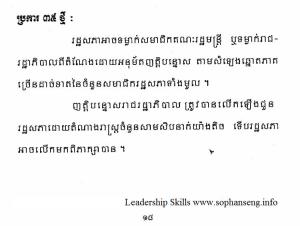 Firstly, truly, Sam Raimsy has projected long term scenario for Cambodia future by putting all efforts since he has become opposition leader. His leadership and method to adopting half+1 is to ensure that Cambodia future change shall be a democratic system of two political parties state. His prediction is correct with the current rolling wheel of the CNRP and CPP.
Firstly, truly, Sam Raimsy has projected long term scenario for Cambodia future by putting all efforts since he has become opposition leader. His leadership and method to adopting half+1 is to ensure that Cambodia future change shall be a democratic system of two political parties state. His prediction is correct with the current rolling wheel of the CNRP and CPP.
Secondly, the key points to implement this new Assembly formula is to alter all political non-will of other parties that have been created to just a pawn or a tool or a decor for the government-led party. It has tremendously discouraged corruption and inefficiency of pluralism.
Thirdly, to actualize the concept of “government of the people, for the people, and removable by the people”. Or it is popularly to say “the people must hold government accountable and responsible, in which the government cabinet is answerable to, and removable by, the majority of parliamentarian”. At the moment, the government-led party CPP has no excuse by assigning blames to any coalition party as the party alone must be responsible, answerable, and removable.
The Goodness and the Challenges of Institution Building Processes:
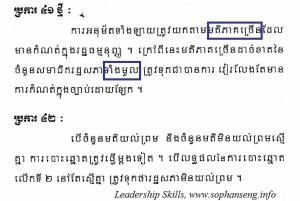 Buddha said “Everything is impermanent (Anicam), decaying (Dukkham), and non-substantial (Anatta). All beings are born, aged, sick, and dead”. Hence, the Buddha established the Sangha institution in which this principle community has survived without focusing much on manpower but using pure principles or Rule of Laws. Buddhist Sangha has lasted more than 2558 years today.
Buddha said “Everything is impermanent (Anicam), decaying (Dukkham), and non-substantial (Anatta). All beings are born, aged, sick, and dead”. Hence, the Buddha established the Sangha institution in which this principle community has survived without focusing much on manpower but using pure principles or Rule of Laws. Buddhist Sangha has lasted more than 2558 years today.
However, the Establishment of Institution is a double-edged sword. A strong Institution could be successful when the principles and institution itself is aiming towards a progress. Historically speaking, Khmer Rouge regime is known for the Demolition of Political Institution. But the arrival of Vietnamese force in the 1979 to replace the Khmer Rouge, has been known for its effort to Establish an Institution. Scholars and observers have noticed that the Institution that has been created by Vietnam since 1979 has remained its lifespan till today, and it is still evidently proven to all of us.
The Processes to Building Institution in Cambodia Requires Efforts, Courage, Dedication, Wisdom, and Participation:
First: this Institution Building is considered a new political movement in Cambodia. It might need a lot of detailed attention. Lord Buddha enlightened first and pushed for enlightenment of many of his disciples after than in order to ensure that the Creation of Sangha Institution is properly put in place. In the age of this Enlightenment Era of the world politics, among those scholars, Marx Weber advocated for the comprehensiveness of this model. So Institution requires knowledge and comprehension to operate it.
Second: the CNRP might face with Khmer outnumbered extreme antagonists from those baby-boomer generations during this process; but it will be accepted and understood by post-baby boomer and silent generation of Cambodia.
Third: the communication skills are in need for intra-party crossing interaction. It is simple and understandable for Sam Rainsy understood Kem Sokha for his public statement about walking out from the parliament if the new National Elections Committee is not successful; and Kem Sokha understood Sam Rainsy for his meeting with Hun Sen to breakthrough the deadlock. Both have already claimed about in need to put personal aside and everything that has been doing has well been communicated by top leaders as CNRP is the Institution. But the party supporters are sometime over-reacted by this unnecessary discretion. Hence, successful Institution has also framed clear bureaucratic hierarchy, duties, obligations, responsibility and accountability. This intra-party communication is also happening to the CPP.
By Sophoan
Attached is the State–Centered and Political Institutional Theory for you to delve into more academical searching.

